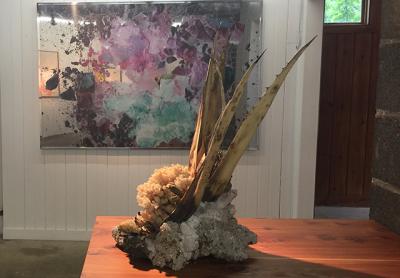Freeman and Lowe Layer It on at Fireplace Project

“Layer it on, you know?” were the last words of Justin Lowe in a 2015 interview in Art News. He was referring to the writer’s comments on an installation he’d constructed in New York that year with his creative collaborator, Jonah Freeman, but he could have easily been talking about the current show at the Fireplace Project in Springs.
“High Rise Lazarus” has the same layered effect, a jumble of works in several series and mediums, or what they refer to as a genre mash-up. Four different series of works are interspersed throughout the space so that their disjunctive and uniting effects can be experienced at once.
Their inspiration, “High Rise Lazarus,” was the product of a group of anonymous amateur authors who, beginning in the 1980s, sought to conjoin a number of science-fiction universes into a single magnum story. They ended up with a grand mess, “a mass of narratives that do not create a unified universe as much as a meandering jump-cut reality,” according to the artists and the gallery.
Not only do the artists borrow the idea of the mash-up, they also address some themes similar to the initial project, such as alternative universes, artificial intelligence, dystopian megacities, drug use, and machine/biological mutation.
The showiest works are the “Chopped Sheetrock Mirrors.” These large-format compositions are in the six-to-eight-foot range and sound simple enough in their description of medium and support: U.V. ink on mirror-polished stainless steel. Yet the process the artists go through to arrive at their imagery is far more complex. A high-resolution scanner captures images of smashed sheetrock that has been combined with Windex, water, food coloring, paint, canned air, and more. The aim is to create an image of a wall, captured in the act of someone smashing through it. The size of the pieces puts the experience in human scale.
What are they aiming at? The artists said in a statement that they are referencing Chicago’s Cabrini Green Housing Projects, buildings constructed so cheaply that residents broke down the walls between rooms and apartments to create a complicated maze for law enforcement agents attempting to raid the buildings. The mirrored background gives these compositions an illusive depth that helps heighten the effect of a broken/open space and a further dimension beyond the crushed wall.
Pieces of sheetrock seem to fly in the air as Pepto-pink walls with teal accents explode. Some of the solvents added to the printing process act as smoke or clouds of dust, adding further drama. The remaining open-mirrored surface captures glimpses of the artwork in the room, layering the visual experience even more.
In keeping with the sci-fi theme are the “Starchamber Collages,” composed of chopped-up book covers from the genre. Here the artists celebrate the “spectacle and cliché of pulp sci-fi” as they create a pastiche of “unlikely and often absurd cut-up illustrations.” Odd-looking but stock alien creatures pop up, as well as “Avatar”-inspired and inspiring figures, like a woman apparently made out of plant life.
Surreal landscapes and sterile urban centers primed for an invasion make up some of the other tropes. Some images come from old advertisements for things like paint. An old stereo receiver looks like a kind of command-and-control device here, even though it was once a common electronic appliance. Groups of ecstatic acolytes surrounding a guru are also a recurrent visual.
The “Cactus Crystal Hybrid” sculptures are in keeping with both the leitmotifs of sci-fi and the idea of a mash-up. These are part of a series the artists have worked on previously, creative fictive organisms that are half plant and half mineral, organic and manmade. In artistic terms, they fall into the category of assemblage. Often spiky and full of texture, the objects could plausibly be thought of as being harvested from an alternate universe’s sea.
While everything in the show was created this year, the one series that seems to not quite work in this environment is the “Narcolepsy Paintings,” which were produced during a residency in East Hampton at Elaine de Kooning’s old house. They too have a complicated back story involving a collector with a predilection for Art Brut paintings, a fetish for primitive objects, and an addiction to naps. As layered as this narrative is, however, it feels out of place, even as the artists claim its “untrained mimicry and the spirit of the unfinished picture” is similar in spirit to the aims of the “High Rise Lazarus” authors.
The exhibition will be on view through Aug. 14.
